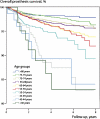Younger age increases the risk of early prosthesis failure following primary total knee replacement for osteoarthritis. A follow-up study of 32,019 total knee replacements in the Finnish Arthroplasty Register
- PMID: 20809740
- PMCID: PMC2917562
- DOI: 10.3109/17453674.2010.501747
Younger age increases the risk of early prosthesis failure following primary total knee replacement for osteoarthritis. A follow-up study of 32,019 total knee replacements in the Finnish Arthroplasty Register
Abstract
Background and purpose: Total knee replacements (TKRs) are being increasingly performed in patients aged < or = 65 years who often have high physical demands. We investigated the relation between age of the patient and prosthesis survival following primary TKR using nationwide data collected from the Finnish Arthroplasty Register.
Materials: From Jan 1, 1997 through Dec 31, 2003, 32,019 TKRs for primary or secondary osteoarthritis were reported to the Finnish Arthroplasty Register. The TKRs were followed until the end of 2004. During the follow-up, 909 TKRs were revised, 205 (23%) due to infection and 704 for other reasons.
Results: Crude overall implant survival improved with increasing age between the ages of 40 and 80. The 5-year survival rates were 92% and 95% in patients aged < or = 55 and 56-65 years, respectively, compared to 97% in patients who were > 65 years of age (p < 0.001). The difference was mainly attributable to reasons other than infections. Sex, diagnosis, type of TKR (condylar, constrained, or hinge), use of patellar component, and fixation method were also associated with higher revision rates. However, the differences in prosthesis survival between the age groups < or = 55, 56-65, and > 65 years remained after adjustment for these factors (p < 0.001).
Interpretation: Young age impairs the prognosis of TKR and is associated with increased revision rates for non-infectious reasons. Diagnosis, sex, type of TKR, use of patellar component, and fixation method partly explain the differences, but the effects of physical activity, patient demands, and obesity on implant survival in younger patients warrant further research.
Figures



References
-
- Amin AK, Clayton RAE, Patton JT, Gaston M, Cook RE, Brenkel IJ. Total knee replacement in morbidly obese patients: Results of a prospective matched study. J Bone Joint Surg (Br) 2006;88((10)):1321–6. - PubMed
-
- Baker PN, Khaw FM, Kirk LM, Esler CN, Gregg PJ. A randomised controlled trial of cemented versus cementless press-fit condylar total knee replacement: 15-year survival analysis. J Bone Joint Surg (Br) 2007a;89((12)):1608–14. - PubMed
-
- Baker PN, van der Meulen JH, Lewsey J, Gregg PJ. The role of pain and function in determining patient satisfaction after total knee replacement. Data from the National Joint Registry for England and Wales. J Bone Joint Surg (Br) 2007b;89((7)):893–900. - PubMed
-
- Berry DJ, Harmsen WS, Cabanela ME, Morrey BF. Twenty-five-year survivorship of two thousand consecutive primary Charnley total hip replacements: factors affecting survivorship of acetabular and femoral components. J Bone Joint Surg (Am) 2002;84((2)):171–7. - PubMed
-
- Changulani M, Kalairajah Y, Peel T, Field RE. The relationship between obesity and the age at which hip and knee replacement is undertaken. J Bone Joint Surg (Br) 2008;90((3)):360–3. - PubMed
MeSH terms
LinkOut - more resources
Full Text Sources
Medical
Research Materials
